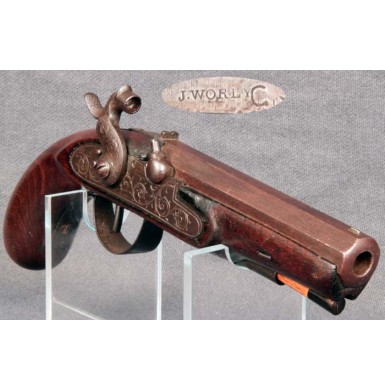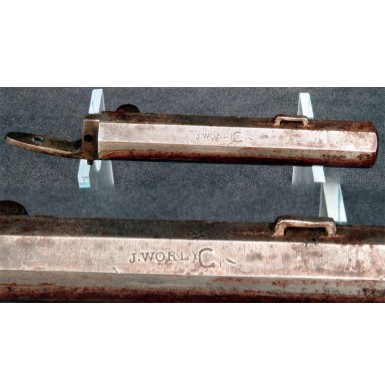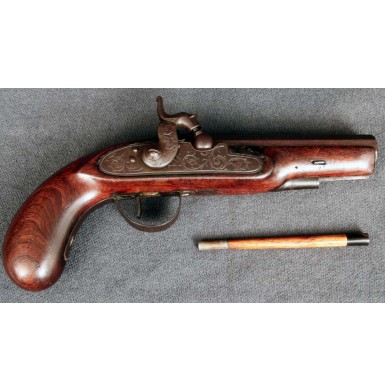Berks County Kentucky Style Belt Pistol
- Product Code: FHG-1392-SOLD
- Availability: Out Of Stock
-
$1.00
This is a really lovely example of an early “Kentucky” style percussion pistol, which was probably manufactured between 1835 and 1840. The gun is completely unmarked externally, which is typical of percussion “Kentucky” pistols. However, the underside of the barrel is marked by famous Berks County, PA barrel maker J WORLY. Jesse Worley (1788-1838) was a Berks County, PA (Mohnton area / Cumru Township) barrel maker, located along the Wyomissing Creek. At least a dozen famous Berks County gunmakers established themselves along this waterway, which provided the necessary power to operate their gunmaking machinery. Worley learned his trade under the tutelage of the Golden Age Kentucky Rifle barrel making Pannabecker family (sometimes referred to as Pennybaker), of Lancaster & Berks counties in Pennsylvania. Worley died at the early age of 50 and his sons John and Theophilus took over the barrel making business in 1838. Jesse typically marked his barrels “I WORLEY”, with the archaic “J” represented by an “I”. However, he marked rifles that he built “JW”. As such, it is difficult to know if this gun barrel, marked “J WORLY” is his work, or the work of his son John. In either case, it is a wonderful example of an early Berks County, PA made “Kentucky” percussion pistol.
The pistol is in about FINE condition overall. The gun is crisp and untouched, and does not appear to have ever been cleaned or sanded. The pistol is about 10” in overall length, making it a large pocket (possibly for an overcoat) or small belt pistol. It has a 5 1/8” long, heavy octagon barrel that has a well executed convex crown at the muzzle. The pistol is about .38 caliber and has a smooth bore. The gun was no doubt intended to accompany a rifle of the same caliber, as a secondary weapon. The barrel appears to have been originally produced for a flintlock gun, but was either reused in this percussion pistol or had never been used and was utilized to create a percussion pistol. The lock of the pistol was clearly always a percussion lock and is not an alteration. The pistol has a lovely, simple walnut stock with a gracefully curved grip. Most of the mountings are all of blued iron and the barrel is secured to the stock by the tang screw and a single iron barrel wedge. The only brass fittings are the lock screw escutcheon and trigger plate, both made of brass. The lock and triggerguard are engraved with matching foliate designs, which are fairly simple and applied in a workmanlike fashion. The trigger guard finial and barrel tang are engraved with matching, simple motifs, which appear to be representing sheaves of wheat. The lock, barrel and furniture were originally blued, and traces of the original blue finish remain on the barrel in protected areas, with the balance of the exposed barrel surface having a lovely plum brown patina. The barrel is almost entirely smooth metal, with only some minor pinpricking present around the bolster area, and some small patches of minor peppering and light surface oxidation, scattered along the barrel. The iron lock and trigger guard have a deep plum brown patina as well. The lock functions crisply and the gun is mechanically excellent, working well on all positions. The lock is secured to the stock by a single screw, which passed through a teardrop shaped escutcheon. The wooden ramrod in the channel under the barrel appears old and has a lovely horn tip and an iron ferrule on the opposite end, which is threaded for use with cleaning implements. The rod may be a replacement, but fits the pistol perfectly and is the correct length for loading the pistol. The stock of the pistol is really lovely and shows wonderful wood to metal fit. It has fine, clean lines and balances and points well in the hand. The stock is free of any breaks or repairs. It does show a minor crack on the flat opposite the lock. The crack travels from the single lock mounting screw to the barrel channel, following a grain line. It is the result of the screw being over-tightened many years ago. It appears completely stable and non-structural. There is also a barely noticeable grain crack at the tip of the wooden forend. It also appears stable and non-structural. Neither of these tiny cracks in any way detract from the display of this lovely pistol. Otherwise, the stock shows only a handful of minor bumps, dings and minor marks from handling and use.
Overall this is a really attractive and complete example of an early percussion era pistol from the celebrated Berks County school of “Kentucky rifle” makers. The gun is simply a wonderful untouched specimen and a lovely example of the smooth, clean lines of the post-”Golden Age” gun makers of the Wyomissing creek area. It is a lovely example of the end of an era. It represents the end of the time when gunmakers were artists who made individual arms by hand, often as works of art. Within a decade of the making of this gun the art of gunmaking had largely given way to mass produced, interchangeable part arms from Northern factories This pistol may well have traveled across the country with opening of the American West, have seen service in the gold fields of California or even travelled to Mexico during that war. No matter how it spent its life, it was well cared for and will now make a great addition to your collection of early American percussion pistols or to compliment your Berks County percussion rifle.
SOLD





